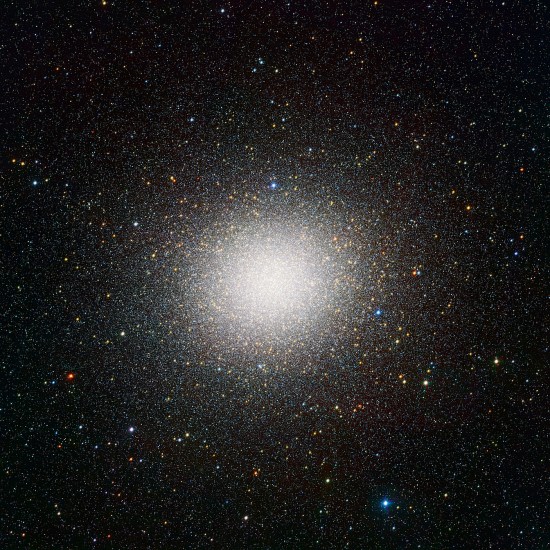
Globular cluster Omega Centauri (NGC 5139). Credit: ESO/INAF-VST/OmegaCAM. Acknowledgement: A. Grado/INAF-Capodimonte Observatory
May 13, 2015
Dark matter used as an excuse—again.
Gravitational theory demands that the tidal forces acting on globular clusters in their orbits as they pass through the plane of a galaxy would disrupt the spheres, leaving a collection of stars that is more open or chaotic than the symmetrical balls that are seen.
By way of background, globular clusters pose a particularly difficult question when a gravitational model of the cosmos is considered. Why do their stars congregate into giant balls, rather than in disks or ellipses? Also, stellar orbits inside the clusters should gradually cause them to disappear over time if their stars are attracted to one another through gravity, alone. Some stars should be accelerated out of the cluster, while stars closer to the center should slide into the gravity well. Since globular clusters orbit galaxies in a halo, each time they cross the galactic plane tidal forces should disrupt them, sending their stars every which way. Why this does not happen is not explained. NGC 5139 is supposed to be hundreds of millions of years old, yet it remains spherical despite crossing the plane of the massive, violent maelstrom called Centaurus A (NGC 5128) many times.
According to a recent press release, a new type of globular cluster has been discovered. Unlike “normal” clusters, the ones observed by the European Southern Observatory in Paranal, Chile reveal strange characteristics.
As Thomas Puzia from the research team said: “Our discovery of star clusters with unexpectedly high masses for the amount of stars they contain hints that there might be multiple families of globular clusters, with differing formation histories. Apparently some star clusters look like, walk like, and smell like run-of-the-mill globulars, but there may quite literally be more to them than meets the eye.”
What is that “more than meets the eye” that makes them so unusual? Dark matter. As the press release states, “Globular clusters are normally considered to be almost devoid of this mysterious substance, but perhaps, for some unknown reason, some clusters have retained significant dark matter clumps in their cores. This would explain the observations but does not fit into conventional theory.”
Explaining observations with data that does not support conventional theory, yet retaining that theory in light of contradictory observations is called “faith”. It might be an elegant solution to a question but it is not science.
In an Electric Universe, galactic evolution can be explained in terms of large-scale plasma discharges that form spinning wheels of coherent filaments. Stars in galaxies tend to coalesce in long arcs like beads on a string, one of a hundred mysteries that conventional cosmology must confront. No gravity-only theory can explain star formation, in general, but the barred spirals and the tremendous elliptical whirlpools that congregate in million-light-year clusters are beyond any conventional definition.
When plasma moves through a cloud of dust or gas, the cloud becomes ionized and electric currents flow. When electricity flows through any substance it forms a magnetic field. One aspect of magnetism in plasma is that it creates what are sometimes called “plasma ropes.” Magnetic fields surround the plasma, confining it into a coherent system known as a Birkeland current.
Every element in a galactic circuit radiates energy, and it must be powered by its coupling with larger circuits. The extent of those larger circuits is indicated by the observation that galaxies occur in strings. The predominant cosmological theories that most astronomers use are based on a gravity-only paradigm. Moving masses and heat are the only factors allowed to operate in their Universe. Electric charge is sometimes considered, but it is usually negligible in its effect, if it has an effect at all.
Several computer simulations have been developed over the years so that what is unobservable can be modeled on the desktop. It comes as no surprise that the observations appear to match the simulations. The same ideas used to construct the computer algorithms are also in the minds of those working with the instruments. Building a device that is designed to see what has been simulated is how modern science works. Mathematical formulae make both possible.
Tightly-bound concentrations of stars in orbits forming a sphere surround the nuclei of many galaxies. The velocities of those stars are conventionally attributed to a massive, or “super massive,” black hole at the very center of the sphere. In an Electric Universe, impossible “black holes” are explained as plasmoids, which store the electromagnetic energy feeding the galaxy in a very compact volume. As the well-known equation relating mass to electromagnetic energy explains (e=mc^2), plasmoids will exhibit an intense gravitational field.
Rather than a mysterious substance that can not be detected, why not use the formulae and observed characteristics that make a plasmoid what it is.
Stephen Smith












